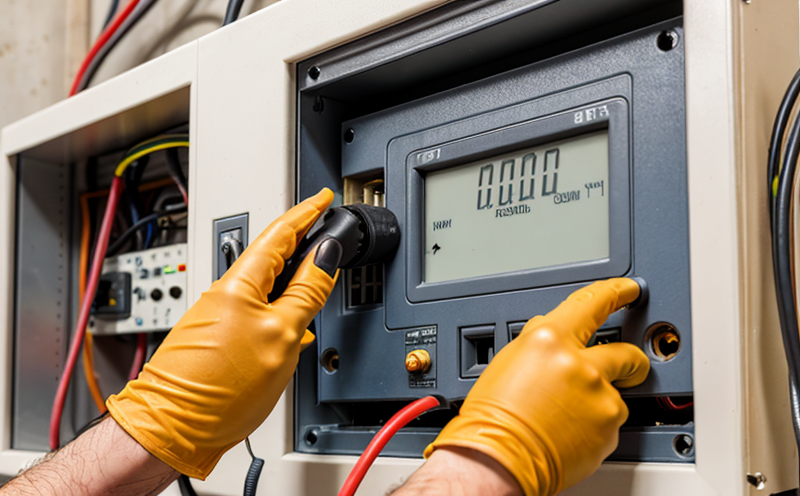IEEE 1188 Functional Testing of VRLA Batteries
The IEEE Standard 1188-2005 provides a comprehensive framework for the functional testing of valve-regulated lead-acid (VRLA) batteries. This standard ensures that batteries meet specific performance criteria, which is critical in ensuring reliability and safety across various applications.
During the testing process, VRLA batteries undergo a series of tests designed to evaluate their electrical characteristics under controlled conditions. The tests include impedance measurements, charging/discharging cycles, and internal resistance checks. These parameters are crucial for understanding how well the battery will perform in real-world scenarios.
The IEEE 1188 standard is widely adopted by industries that depend on reliable power sources, such as telecommunications, data centers, and uninterruptible power supply (UPS) systems. By adhering to this standard, manufacturers can ensure their products meet the highest quality standards and are fit for purpose.
The testing process typically involves several steps:
- Visual inspection of the battery and its components
- Measurement of terminal voltage before and after charging/discharging
- Determination of internal resistance using impedance analysis
- Evaluation of specific gravity if applicable
- Recording of temperature during tests to account for thermal effects
| Test Parameter | Methodology | Acceptance Criteria (IEEE 1188) |
|---|---|---|
| Terminal Voltage Measurement | Measure voltage with a high-precision multimeter during charging and discharging cycles. | Voltage should not drop below 2.17V per cell under specified conditions. |
| Internal Resistance Determination | Use impedance analysis techniques to measure resistance changes over time. | Resistance must remain within manufacturer's specifications and IEEE standards. |
| Specific Gravity (if applicable) | Determine the specific gravity using a hydrometer or refractometer. | Gravity should be within ±0.05 of nominal value for flooded cells. |
The testing process is rigorous and ensures that VRLA batteries are reliable under various conditions. The data collected during these tests provides valuable insights into the battery's performance characteristics, helping manufacturers identify areas for improvement.
By following IEEE 1188 standards, laboratories can provide accurate and consistent test results, which are essential for maintaining high-quality products in demanding environments. This standard is particularly important for industries where uninterrupted power supply is critical, such as telecommunications and data centers.
Customer Impact and Satisfaction
The implementation of IEEE 1188 functional testing ensures that customers receive batteries that are reliable and meet the highest quality standards. This standard is particularly beneficial for industries where power outages could have severe consequences, such as telecommunications and data centers.
By adhering to this standard, manufacturers can ensure their products meet stringent performance criteria, which enhances customer confidence in the reliability of their batteries. This, in turn, leads to higher satisfaction levels among customers who rely on these critical power sources.
The testing process is designed to identify any potential issues early on, allowing for timely corrective action. This proactive approach not only improves product quality but also reduces downtime and associated costs for end-users. In industries where uptime is essential, such as data centers, the ability to quickly resolve issues can mean significant financial savings.
Furthermore, by providing accurate test results that comply with international standards, laboratories can help customers meet regulatory requirements and improve their overall compliance posture. This is particularly important for organizations operating in highly regulated industries where non-compliance could result in costly penalties or operational disruptions.
The IEEE 1188 standard ensures that VRLA batteries are tested under controlled conditions that mimic real-world use cases, providing customers with confidence in the performance of their power sources. This standard is especially valuable for organizations looking to improve their environmental sustainability efforts by ensuring they are using reliable and efficient energy storage solutions.
Environmental and Sustainability Contributions
- VRLA batteries tested according to IEEE 1188 standards are more likely to perform efficiently, reducing the need for frequent replacements and minimizing waste.
- The testing process helps identify potential inefficiencies in battery performance, allowing manufacturers to make improvements that enhance overall sustainability.
- By ensuring reliable power sources, organizations can reduce their environmental impact by optimizing energy usage. This is particularly important in data centers where power consumption is a significant factor.
- The standard promotes the use of reliable and efficient batteries, which can help minimize greenhouse gas emissions associated with backup power generation.
Adhering to IEEE 1188 standards not only ensures reliability but also contributes positively to environmental sustainability. By reducing waste and optimizing energy usage, organizations can play a crucial role in promoting sustainable practices within their industries.
Use Cases and Application Examples
- Data Centers: Ensuring uninterrupted power supply is critical for data centers. Testing VRLA batteries according to IEEE 1188 standards helps maintain reliability and availability of power sources.
- Telecommunications: In the telecommunications sector, reliable backup power systems are essential for maintaining network connectivity during outages. IEEE 1188 testing ensures that these systems perform as expected.
- Uninterruptible Power Supply Systems (UPS): UPS systems rely on VRLA batteries to provide immediate power in case of a power failure. Testing according to IEEE standards helps ensure their reliability and longevity.
- Hospital Emergency Backup: Hospitals depend on reliable backup power for critical operations. Testing VRLA batteries using IEEE 1188 ensures that these systems are ready when needed.
These use cases demonstrate the importance of IEEE 1188 functional testing in various industries where uninterrupted power supply is essential. By adhering to this standard, manufacturers and laboratories can ensure that VRLA batteries meet stringent performance criteria, enhancing reliability and safety across different applications.





